

|
Back to |
| The Front Page |
| Letters & Opinion |
|
Croquet at War
|
|
|
By Dr. David Drazin Photographs courtesy of the National Croquet Museum and Gallery Posted March 1, 2004
|
|
David Drazin, croquet’s bibliographer, has amassed the most comprehensive collection of croquet-related books and pamphlets in existence, the essential raw resource of genuine historical research. These materials, combined with careful study and analysis and the fruits of the labors of earlier historians, will doubtless enrich the most sweeping and original history of croquet ever written. Dr. Drazin and his co-authors hope to complete the work in the next few years. In the meantime, the croquet community can enjoy byproducts of ongoing research that spans the globe. One penetrating speculation to be published in some form in this online magazine in the near future sheds new light on “The Source of Deadness in North America.” The article below, published by permission of the author and The Croquet Gazette, offers insights into the historical fortunes of croquet amidst and around the tumult of war over the last 150 years. .
You don't have to believe in chaos theory to see war as a force for change in the croquet world.
The fortunes of war offer a rich source of material upon which to ponder the question that must recur in the mind of anyone looking back at the history of croquet. 'What if ...?' The several varieties of the game played today in different parts of the world probably all stem from the primitive game of tight croquet that emerged mysteriously in Ireland in the early years of the nineteenth century, and then evolved in different ways in response to local conditions. But it might well have been otherwise. [Editor’s note: “Tight croquet”, as opposed to the later evolved “loose croquet” requires holding the striker’s ball in place on the croquet stroke.}
Very soon after croquet arrived in England from about 1850, it was re-exported in much the same inchoate form by travelers to the British colonies, North America, and mainland Europe. But no more than a few years later developments of the game in Britain and the USA took different paths.
The British game was launched on a course of continuous refinement, marked by The Field Laws of 1866, the Conference Code of 1870, and the introduction of the Hale six-hoop setting in 1872. By contrast, the American game made no coherent nation-wide advance until the foundation in 1882 of the National American Croquet Association, which embarked on a radical course of reform, leading to the establishment of roque, played on a hard court like an outsize billiard-table, allowing 'carom' strokes off the sideboards, as the American national game.
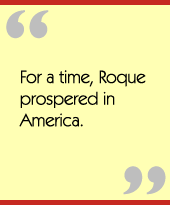
For a time, Roque prospered. In 1889 the NACA changed its name to the National Roque Association and by 1933 it listed 176 clubs.
But events might have taken a very different turn had it not been for the American Civil War, which consumed the nation's energies from 1861 to 1865. We know that croquet was established in New England before the war and can reasonably assume that it continued to be played in private homes while the Yankee and confederate armies were locked in mortal combat. Men might have been in short supply, but a good few dodged the draft. Just as now, money spoke. If you stumped up the going price, you could pay for a substitute to march to war in your place.
At all events, it is clear that in the early 1860s, when the British game was roaring ahead, the American game was frozen in the era of crinoline croquet. In Britain, town squares were given over to croquet grounds, books on the subject clocked up serious sales, and the sports correspondents of such influential journals as The Field were leading a crusade to infuse rigor into the game.
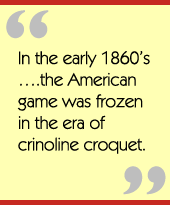
In America the game caught fire no less dramatically, but only at the end of the war. The time lag is nicely illustrated in the table below by the numbers of croquet books and articles I have traced year by year from either side of the Atlantic.
Books Magazine Articles
UK USA UK USA
1861-63 7 - 17 -
1864 5 - 64 1
1865 5 5 41 6
1866 6 3 44 8
|
Of course, we shall never know, but it is intriguing to speculate that, had it not been for the Civil War, advances in the game either side of the Atlantic might have marched in parallel rather than in different directions.
The world wars of the last century pose other questions. Were they merely responsible for blips in the onward march of croquet, or did they influence the longer-term development of the game in some more fundamental ways? And what was their impact on the game at national and club levels and in the world at large? The Croquet Association Gazette, which continued to be published during both wars, albeit less frequently, offers some fascinating insights.
The Great War broke out in the summer of 1914. No one had any idea what to expect, and in the early months the Croquet Association followed the government's call to carry on 'business as usual'. It was only towards the end of the croquet season, as mobilization got into full stride, did it dawn on the nation that the war would soon come to dominate everyone's lives, and might continue to do so for years rather than months. Most of the late season official events were cancelled, either as a matter of practical expediency or out of a sense that they represented a form of indulgence inconsistent with a national emergency; but club play continued much as usual on a reduced scale, and there were even prospects of winter play on the French Riviera. An advertisement by the Menton Syndicat des Hoteliers assured readers 'The Season 1914-15 will be quiet and "Germanless," an old-fashioned Mentone Season with Croquet, Tennis and Golf as usual'.
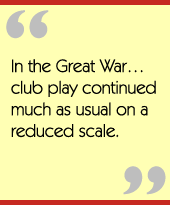
During the first year of the war, the correspondence columns of the Gazette focused on two issues: the propriety of tournament play at home while the armed forces were locked in mortal combat overseas and the CA Council's decision to hold the ordinary Associate's subscription for 1915 at £1, even though there were no plans to hold the usual official events and the Gazette was to appear less frequently.
On the cancellation of calendar fixtures, E.L.W. wrote in the 17 September 1914 issue 'that a game of croquet at this time does more good than usual to us who have to stay at home', while B.M. Gatehouse countered 'How anyone calling themselves British can think or talk of playing in croquet tournaments while our kith and kin are fighting in this terrific struggle is incomprehensible'.
Defending theCA's subscription policy in the 28 January 1915 issue, Lord Doneraile, Hon Treasurer, was uncompromising: 'In the first place, the Subscription of Associates is fixed by the Rules of the Association and is not liable to variation on account of circumstances or expedience.... In the second place, the number of Tournaments on the Calendar has not a direct bearing on the question.... In the third place, a reduction in the number of issues of the Gazette , after the conclusion of the current volume, will not necessarily imply any large saving of expenditure....'
But prophetically, as we shall see, A.C. Holland was unconvinced: 'In the face of the improbability of there being any Calendar fixtures for 1915 would it not be politic to dry dock the Croquet Association by reducing members' subscriptions to a nominal 2/6 and the issues of the Gazette to once a month? ... By this means a wholesale resignation of members would be avoided, and the following of the game preserved.'
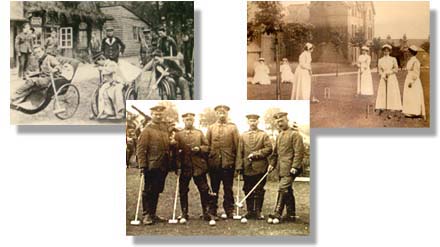
|
| Croquet reflected a lost age of civility quite at odds with the horrors of the first “modern” war, which was called The Great War and “the war to end all wars.” These three photographs from the collection of the National Croquet Museum, all from around 1915, show how croquet was used everywhere as a distraction from battle and its aftermath: wounded Canadians playing croquet; German cavalry with their mallets, shielded by a cannon pointed at the battlefield behind them; and ever-so-tidy Worchester nurses taking a croquet break. |
As the war continued with no end in sight, the Gazette assumed a lower gear. It appeared irregularly and shrank in size, the newsprint deteriorated, and it made grimmer reading. The roll of honor, military and naval appointments of Associates ('Croquet Players and the War'), military honors for croquet players, and appeals by a plethora of wartime charities became regular features. The first Associate to lose his life in action was apparently Capt R.Y. Sidebottom of the Lancashire Fusiliers. He was reported in the 10 September 1914 issue as having been wounded, and on 1 April 1915 as having been listed unofficially as killed. The roll of honor lengthened inexorably. The final roll, which appeared in the 5 December 1918 issue, named 19 Associates.
The lists of those who served and died in the armed forces cast the social structure of the contemporary croquet community in sharp focus. Of the 179 Associates reported as serving in the armed forces in September 1916, 93 per cent were of officer rank, as were 17 of the 18 who were killed in the war. There could be no clearer evidence that croquet was almost exclusively the preserve of the middle and upper classes.
Though the CA abandoned official tournament play soon after war broke out, most clubs continued to function as best they could throughout the war and a few of the larger clubs held open tournaments that were advertised and reported in the Gazette . And C.D. Locock continued in his role as CA Handicapper, albeit on a reduced honorarium, publishing handicap changes.
On the home front players were thin on the ground, and a number of clubs touted for visitors to help augment their numbers and justify the facilities they had preserved. Much like old soldiers, croquet clubs do not die, or at least their deaths are not reported at the time. They only fade away. Of the 165 registered clubs in the British Isles listed in the 1915 edition of The Croquet Association Year Book, 28 are missing from the first (1920) post-war edition.
Taking a wider view, croquet seems to have weathered the war years with extraordinary resilience. The National Roque Association of America held its annual open championships at Norwich, Connecticut, continuously throughout the war, and the Victorian Croquet Association and All-Ireland Croquet Association did likewise at least until 1916.
I have not been able to piece together precisely what was happening down under, but it is clear that Australian croquet was making great advances. In a letter to the Gazette of 18 October 1917, Macpherson Robertson, who later founded the MacRobertson Shield series, told the world how he had just accomplished a 'primary septuple peel ' (ie peeling one's partner ball through the first seven hoops in a single turn) in practice.

And the very fortunes of war must have introduced countless new players to the game. In particular, we see that croquet was widely adopted at home and abroad as a recreation by servicemen behind the front lines (see illustrations). The Gazette published a number of letters from military convalescent hospitals, appealing for spare croquet equipment and clothing.
Taking stock of the impact the war had on croquet as a competitive sport, it is hard to resist the conclusion that the game suffered a major long-term setback, at least in England, and, had it not been for the war, might even now be in a much stronger position. Membership of the CA peaked at 2310 in 1910, levelled out at about 2300 towards the start of WW1, plummeted to 1457 in 1919, and declined still further on the approach of WW2.
But it was perhaps not so much the war itself that hit the game as the policy adopted by the CA Council in response to it. Standing by the established rule of the Association that Associates were required to pay subscription arrears in full, it alienated about a third of the Association's membership. It makes little sense to speculate on what might be the state of the game today had it been otherwise, but it is a fair bet that it would occupy a significantly higher position in the league of minority sports.
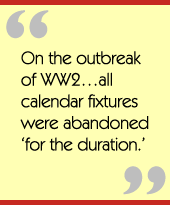
With the benefit of the experience of WW1, on the outbreak of WW2 the CA promptly battened down the hatches. All calendar fixtures were abandoned 'for the duration'; the annual subscription of £1 was replaced by a single War-time subscription of 10s; and an ad hoc caucus of the Council, those members who fortuitously lived in the South West ('The Devon Committee'), ran the shop as best they could. The CA Gazette was published just once a year. Writing in the first of seven War Emergency numbers, issued in May 1940, Chairman G.F. Handel Elvey struck a statesmanlike note that all could endorse: '... while endeavouring to bear cheerfully such burdens as are laid upon us, and making whatever contribution we are able to the national effort, for the rest we can adopt the principle of "business as usual," and try to keep normal activities going, in the hope that, black as it may be, the war-cloud will pass and the blessing of Peace may return.'
Club News became a regular feature of the Gazette. As year followed year, the clubs struggled for survival against mounting odds. Whole grounds were requisitioned by government to aid the war effort, club buildings were destroyed by enemy action, courts were put under the plough to Grow for Victory, supplies of croquet balls dried up, court maintenance suffered owing to shortages of fuel and labor, and attendance at club events declined owing to transport difficulties.
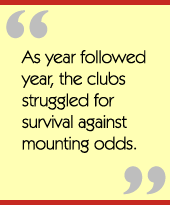
The Gazette for 1944 contained reports from 20 clubs. Most struck a restrained upbeat note, but the writing was plainly on the wall. The Carlisle club had closed down 'owing to a very decreased membership'; Guildford was being 'disbanded owing to there being very few players available'; and there was concern at Surbiton that, owing to the dearth of new members, 'eventually the Club must die out'.
But these 20 reports were no more than the tip of the iceberg. Beneath the waves, the situation was even more dire. It was estimated that the number of CA Associates had dropped from 1291 in 1939 to no more than 500-600 in November 1945; and of the 99 British clubs listed in the 1939 Croquet Association Year Book, only 40 were listed in the next (1947) edition. The war had dealt the CA a savage blow: it was not until 40 years later that membership levels regained their pre-war strength.
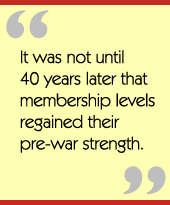
And the picture worldwide was seemingly no brighter. The National Roque Association of America cancelled its annual championships during the years 1942-45, and never regained its pre-war vitality.
What do we learn from these events about the long-term viability of a game that has seen such amazing ups and downs since its beginnings some 150 years ago? We may be on the up right now, but what resources do we have to withstand any future international cataclysm? The impression I am left with justifies guarded optimism. Though, as we have seen, the higher reaches of the game and the governing bodies that support it are quick to suffer from national emergency and very slow to recover, croquet is so deeply embedded in our culture that we need have little fear for its future. Even in the throes of WW2, we see that the spirit of croquet shines through the darkness - sometimes in the most unlikely places, sometimes leaving bright patches, which may have a profound influence on the future development of the game.
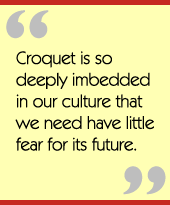
Writing in the Victory number of the Gazette, 'VJ (7)', at the end of the war, Robert Tingey reported that croquet had been played continuously throughout the war at the Gezira Sporting Club, Cairo. Visiting members of the British armed forces, including a few A class players, seized the opportunity to hone their playing skills, and did much to raise the level of club play. Owing to the fluctuating number of players, Russian, French, and Golf Croquet were especially popular.
I have not been able to discover how the Egyptian game developed in the immediate post-war years, but it could well be that the wartime influx of CA Associates in uniform sowed the seeds that gave rise to the supremacy of Egyptian players in Golf Croquet. If Golf Croquet should prove influential in raising the profile of croquet in general, future historians may justly point to the war as the original cause.
And if Roque had not lost its momentum after the war, the movement that led to the foundation of the United States Croquet Association may never have got under way.
Note: This article is reprinted by permission of the author and The Croquet Gazette. The photographs, shown here by permission of the Croquet Foundation of America’s National Croquet Museum and Gallery, were originally collected by Allen Scheuch of New York. The permission granted is for a one-time use on the Internet to accompany the article above. These historical photographs and many works of art with croquet themes are on continuous display it the Museum Gallery at the National Croquet Center in West Palm Beach, Florida.